Giant swords chasing demons, “royal toilets,” and embalming workshops are among the discoveries that have astonished archaeologists this year.
Bronze Mirrors and Giant Swords in Ancient Japanese Tombs
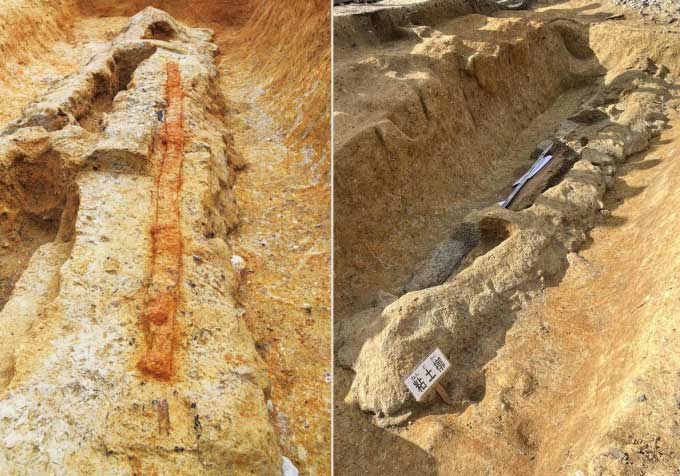
The 2.37 m long sword discovered in an ancient tomb. (Photo: Kashihara Archaeological Institute, Nara Prefecture).
The Buried Cultural Properties Research Center of Nara City and the Kashihara Archaeological Institute in Nara Prefecture announced fascinating and unprecedented findings on January 25. These discoveries include a shield-shaped bronze mirror and an oversized iron sword found in the Tomiomaruyama Kofun. This is the largest round kofun burial mound in Japan, dating back to the latter half of the 4th century.
The Buried Cultural Properties Research Center of Nara City began excavating Tomiomaruyama in 2018. This year, the team uncovered a part of the kofun known as “tsukuridashi” – the raised section in the middle of the burial mound – and found a 5-meter-long wooden coffin.
They also discovered the iron sword and the bronze mirror within the clay layer covering the coffin. This is the first time a shield-shaped bronze mirror has been found at an archaeological site in Japan, boasting the largest surface area of any bronze mirror excavated in the country.
The sword from the Tomiomaruyama kofun measures 2.37 meters long and 6 centimeters wide. It is a type of sword known as dakoken, featuring a blade that is slightly curved like a serpent. This is the largest intact sword discovered at an archaeological site in Japan. According to experts, the sword serves a ceremonial purpose to ward off demons rather than being a functional weapon due to its enormous size.
The “Royal Toilet” of China
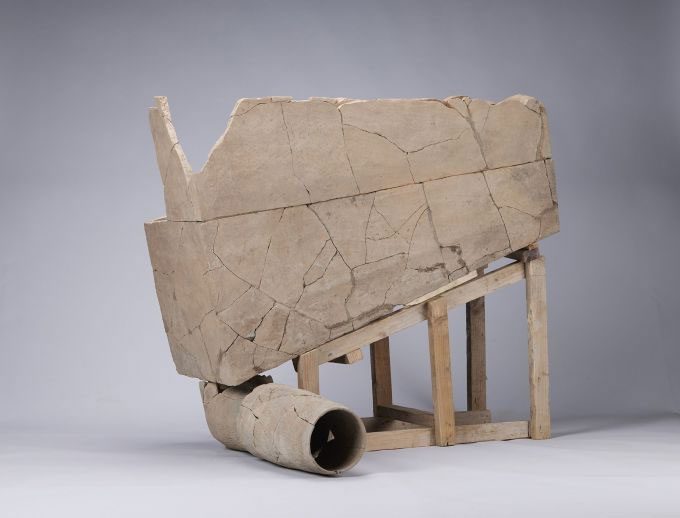
Damaged parts of the toilet, including a curved pipe, excavated from the archaeological site of Yuyang in Xi’an, Shaanxi Province. (Photo: China Daily)
In February, archaeologists revealed they had unearthed the lower half of a 2,400-year-old manual flushing toilet at the Yuyang archaeological site in Shaanxi Province, China. Yuyang served as the capital of the Qin dynasty for about 35 years and was also the first capital of the Han dynasty.
The team of experts believes that this toilet was used by high-status figures, such as Duke Xiao of Qin (381 – 338 BC) or his father (424 – 362 BC) during the Warring States period (475 – 221 BC), or Liu Bang (206 BC – 220 AD) – the first emperor of the Han dynasty. This new discovery in China is significant because previously, the first manual flushing toilet was thought to have been invented by John Harington for Queen Elizabeth I in the 16th century.
“This is the first and only flushing toilet ever excavated in China. Everyone at the site was amazed, and then burst into laughter. The toilet provides authentic evidence of the importance of sanitation to ancient Chinese society,” said Liu Rui, an archaeologist at the Archaeological Institute of the Chinese Academy of Social Sciences.
The discovery sheds light on the technological advancements of the Qin and Han dynasties. The construction and use of flushing toilets require knowledge of water supply, waste management, and sanitation, which were uncommon during this period. The finding also offers more insights into the daily lives of high-status individuals living in palaces and accessing luxury amenities.
Secret Corridor in the Great Pyramid of Giza
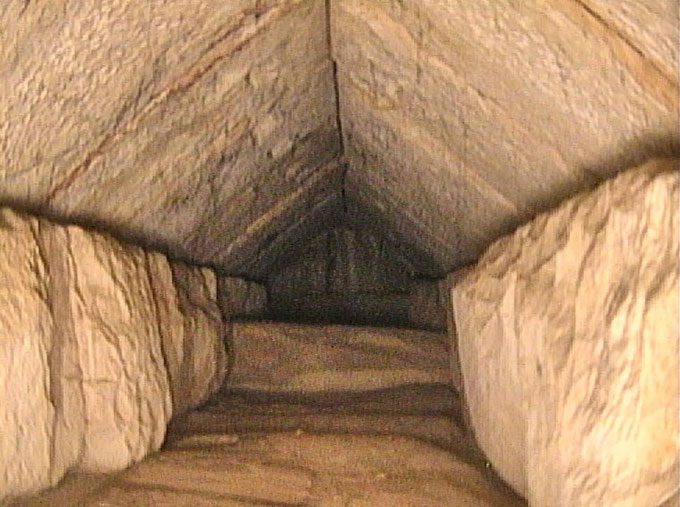
Images from scans showing no artifacts inside the corridor. (Photo: ScanPyramids Mission).
The Great Pyramid of Giza was built under the orders of Pharaoh Khufu (reigned from 2551 to 2528 BC) on the Giza Plateau and currently stands about 139 meters tall. It is the only remaining wonder of the ancient world and was the tallest structure on Earth until 1311. This year’s research findings indicate that just above the ancient entrance of the pyramid is a corridor measuring 9 meters long, 2 meters wide, and 2 meters high. This corridor is located behind the V-shaped structure visible from outside the pyramid, according to research published on March 2 in the journal Nature Communications.
Scientists discovered the corridor while analyzing muon scan images of the 4,500-year-old Great Pyramid. Muons are negatively charged elementary particles formed when cosmic rays collide with atoms in the Earth’s atmosphere. These high-energy particles constantly rain down on Earth but interact with rock differently than with air.
The 9-meter-long corridor was likely created to alleviate pressure from the weight of the construction materials used in the Great Pyramid, according to Zahi Hawass, former Minister of Antiquities of Egypt. Its position behind the V-shaped structure helps distribute the weight. Further research on the corridor could help scientists gain a better understanding of how the pyramids were constructed.
Two 2,400-Year-Old Embalming Workshops in Egypt
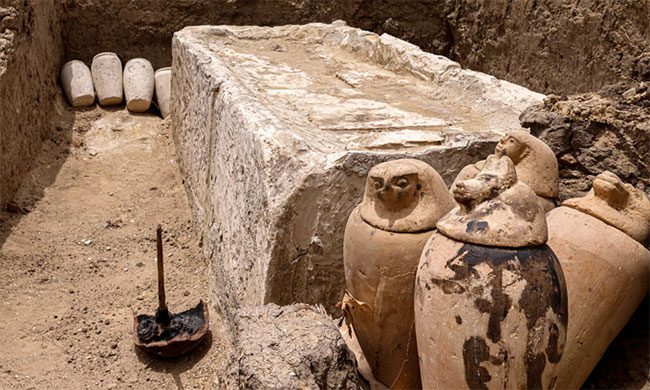
Clay jars and ceremonial vessels placed around stone beds used for embalming in the Saqqara necropolis, south of Cairo. (Photo: AFP).
In May, Egyptian archaeologists announced the discovery of two embalming workshops for humans and animals, along with two tombs at the Saqqara necropolis south of Cairo. This vast necropolis is located in Memphis, the capital of ancient Egypt, and is recognized as a UNESCO World Heritage Site. It features numerous pyramids, animal tombs, and ancient monasteries.
The two embalming workshops, where the bodies of humans and animals were processed, date back to the 30th Dynasty of ancient Egypt (approximately 2,400 years ago), according to Mostafa Waziri, head of the Supreme Council of Antiquities in Egypt. Research into these structures helps scientists gain further insight into the ancient Egyptian mummification practices, a custom that aimed to preserve the bodies of the deceased for the afterlife, dating back to around 2600 BC.
The Egyptian Ministry of Tourism and Antiquities reported that the research team found several rooms with stone beds where the deceased were laid for embalming in the first workshop. At the end of each bed, there were troughs to facilitate the embalming process. Nearby, clay jars were also placed to hold organs and viscera, ceremonial vessels, and other instruments. Preliminary studies indicate that the second workshop was used for embalming sacred animals.
Gold Necklace Containing Megalodon Teeth on the Titanic
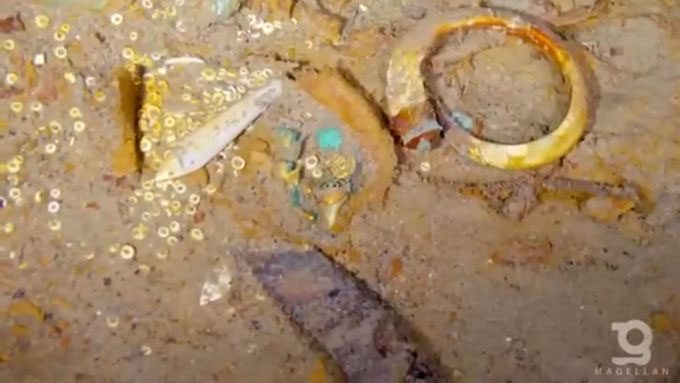
The exploration company will keep the necklace containing Megalodon teeth in its current state. (Photo: Magellan).
Magellan, a company based in Guernsey near the French coastline, announced the discovery of a special necklace in May of this year. Megalodon was a gigantic shark that went extinct about 3.6 million years ago. As the largest shark to have ever lived, the oldest megalodon skeleton dates back over 20 million years. The largest megalodon could reach lengths of 15 to 18 meters, according to the Natural History Museum in London. Megalodon teeth can measure up to nearly 18 centimeters, although fossils typically range from 8 to 13 centimeters.
Magellan did not remove the necklace containing the megalodon teeth from the wreck of the Titanic, the famous luxury passenger ship that sank 111 years ago, due to an agreement between the U.S. and the U.K. The company is working to identify the necklace’s owner with the assistance of artificial intelligence (AI). Experts are using AI to analyze footage of passengers boarding in 1912, examining their clothing while deploying recognition techniques.
Magellan’s scan of the Titanic could help create a real 3D model or high-resolution digital replica of the wreck like never seen before. Since the wreck lies at depths of over 3,800 meters, fully observing the area is quite challenging. The new model will allow people to zoom in and closely examine the entire wreck for the first time.




















































